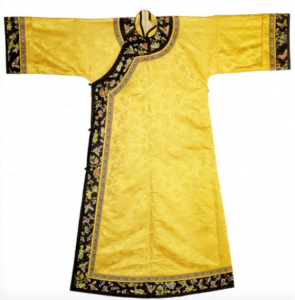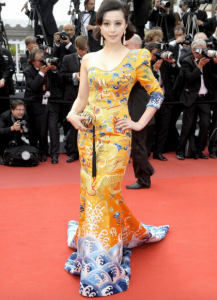The qipao as we know it has existed for the better part of century. However, long before that, the qipao was a standard item of dress and fashion. The oldest version of a qipao that is still visibly connected to what modern fashion gurus would consider a qipao dates back to the 1890s. This type of robe was made of brightly colored yellow silk and had the same high neck we see in modern qipaos. It also had intricately embroidered floral accents to give the gown dimension and make it more beautiful. The buttons used to fasten the robe closed are made of silk cord knots. The embroidery we see in this early qipao are of flowers and vines, they are traditional and beautiful and reflect even older fashion trends from previous dynasties.

1890s Ladies Silk Robe
If we skip forward only 40 years, the qipao is much changed. This 1930’s qipao looks much more like what we expect with its capped sleeves and form fitting cut. The same standard features of the older qipao are present with silk cord buttons, high collar, and intricate design. Yet, it is a much changed dress. The pattern on this qipao is modern and printed. It reflects a change in the direction of a more industrial process for making clothing. It also is a simple pattern of one image repeated over and over again. In the earlier qipao robe, the illustration is more like a scene with a continuous vine running through the robe. Here the pattern is a distinct and intentional detachment from the older more traditional design of embroidery.

1930s Printed Silk Qipao Artist/maker unknown, (1930s) Reproduced from ArtStor.
In a photo from the 2010s the famous Chinese actress Fan Bingbing is shown wearing a modern qipao. The gown she wears in this image is clearly a modern adaptation of a historical fashion item with its statement one-shoulder and trailing train cut. Though, despite its being modern in style, the dress itself is more true to the historical roots of qipao than even the dress from the 1930s shown above. Here Bingbing’s gown is the historically relevant color of yellow which is an extremely honorable color used in pre 1900s Chinese fashion. Furthermore, the embroidery is similar to gowns from the Manchu time period when the embroidery was meant to show a scene and not a pattern.

The important of the patterns here is historically relevant. If we take the first silk robe in this post to reflect the historical values and role of fashion in politics, then the comparison to the qipao from the 1930s is clear. It is far more reflective of a more democratically based government and shows a shift into the industrial age of machine made fabrics. Then, ultimately the shift back to more historically respectful trends in qipao are seen in the last photo. Here the qipao is being used to reflect the history of Chinese fashion. It is a modern cut, but with historical embroidery and design. This is an interesting arc in the qipao’s fashion resurgence, that in order to re-emerge as a fashion trend in the 2000s, it has to be even more historical than the qipao from 1930.
the post could be much more persuasive should you address the question of what the change/transformation of qipao suggests and make an argument at the beginning
